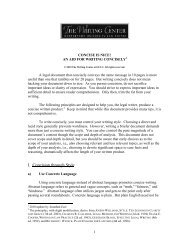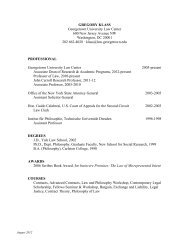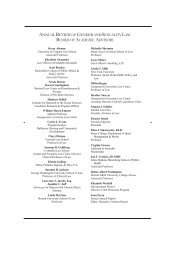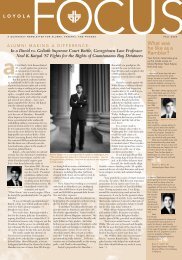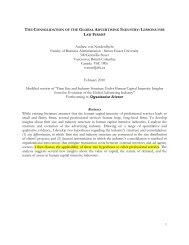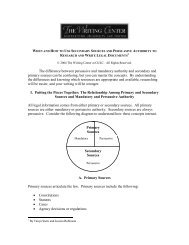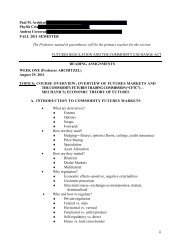Date: April 12, 2013 Topic: The Shrinking ... - Georgetown Law
Date: April 12, 2013 Topic: The Shrinking ... - Georgetown Law
Date: April 12, 2013 Topic: The Shrinking ... - Georgetown Law
Create successful ePaper yourself
Turn your PDF publications into a flip-book with our unique Google optimized e-Paper software.
Executive Summary of Key Findings <br />
General Counsel with Power? 2011 <br />
Size and shape of legal departments <br />
• In-‐house legal departments reflect the structure of businesses. Some in-‐house legal functions <br />
are centralized at the corporate headquarter, whilst others are decentralized to a varying degree <br />
to business and geographic units. <br />
• In-‐house legal departments’ reliance on external legal resources varies enormously. This study <br />
identified a range from <strong>12</strong>% to 93% in the proportion of external to total legal spending. <br />
• <strong>The</strong>re are four types of general counsel with respect to their make-‐or-‐buy decisions, namely <br />
Externalizer Type I, Externalizer Type II, Mid-‐ranger, and Internalizer. Externalizer Type II <br />
(proactively managing legal networks) and Internalizer (in-‐sourcing actively) are the ones with an <br />
appetite for change in legal services. <br />
Convergence, panels, and legal networks <br />
• Panels mean different things to different general counsel due to differential emphasis placed on <br />
competition and collaboration in managing a panel. <br />
• On convergence, GCs who believed in competitive selection for a panel followed by close <br />
collaboration reduced the number of law firms more rigorously than those who wished to <br />
retain competition within a panel. <br />
• Online bidding for legal work was used selectively both within the panel and to identify new <br />
providers. <br />
• <strong>The</strong> most collaborative form of a panel took the shape of ‘legal networks’, in which the general <br />
counsel facilitated lateral collaboration amongst the law firms to deliver services as an extension <br />
of the in-‐house legal function. <br />
A Production-line approach to legal work <br />
• A production-‐line approach to delivering legal work consists of three steps: disaggregation and <br />
standardization, process flow management, and project management. <br />
• Many general counsel found a variety of reasons to reject or delay the wholesale adoption of <br />
this production-‐line approach. <br />
• In practice, the general counsel adopted either a craft approach, an automation approach, or a <br />
process flow approach. Internalizers tended to lead in implementing a combination of <br />
automation and process flow approaches. <br />
What do lawyers do in a multi-sourcing world? <br />
• Multi-‐sourcing – the use of multiple sources of legal service delivery – is likely to change the <br />
contour of global value chains in legal services. <br />
• Value migration away from the traditional corporate client – law firm transactions is more <br />
likely due to three factors: (a) the more the motive for offshoring and near-‐shoring goes beyond <br />
mere labour cost arbitrage to the implementation of a production-‐line approach, (b) the more <br />
lead is taken by the in-‐house legal function in project management, and (c) the higher up the <br />
priority list the general counsel places the issue of efficient legal service delivery. <br />
2 <br />
Said Business School | University of Oxford



